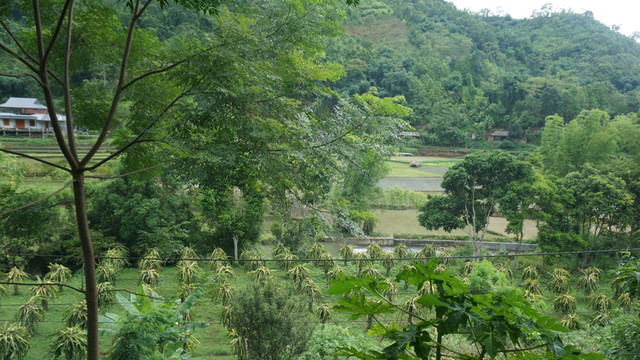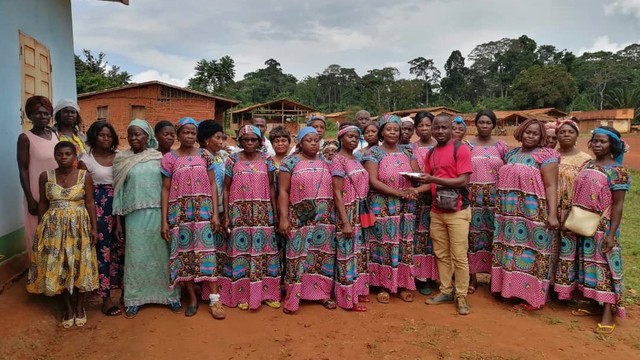Achieving 30x30: supporting Indigenous and traditional territories and cultures
If the world is to halt and reverse biodiversity loss by 2030, we must support Indigenous Peoples and local communities to strengthen and protect their territories and cultures, and ensure their full and meaningful participation in developing conservation policy.


Rabai Kaya elders visiting Kaya Kambe, Kenya (Photo: Krystyna Swiderska/IIED)
The new Kunming-Montreal Global Biodiversity Framework (GBF), agreed in December 2022, sets out an ambitious agenda to halt and reverse biodiversity loss by 2030.
Target 3 – also known as the 30x30 Target – requires 30% of the world’s land and water, especially areas with important biodiversity and ecosystems, to be conserved by 2030 through protected area systems or “other effective area-based conservation measures” (OECMs), recognition of Indigenous and traditional territories, and respect for the rights of Indigenous Peoples and local communities.
To achieve this, we need to almost double the world’s land-based conserved areas and quadruple those at sea from 2020 levels. This offers an opportunity to catalyse much-needed support to protect the land rights of Indigenous Peoples and local communities and ensure new efforts do not violate their rights, as many state-protected areas have done in the past.
Effective approaches
Indigenous Peoples manage a quarter of the world’s land area, including vast landscapes and seascapes, outside of protected areas, that contain many of the world’s important biodiversity sites. At the same time, many developing countries cannot afford to further expand costly protected areas, either politically or financially.
So, recognising and supporting the territories of hunter-gatherers, smallholder farmers, pastoralists, fisherfolk and other Indigenous Peoples and local communities who have conserved nature for centuries will be crucial for meeting the 30x30 Target.
Evidence shows that Indigenous-governed territories conserve biodiversity effectively. A 2019 global biodiversity assessment found that biodiversity is generally declining less rapidly on lands managed by Indigenous Peoples, who actively conserve it based on culturally-specific worldviews; on the other hand, many protected areas are not effectively or equitably managed.
Globally, over 50% of protected areas overlap with Indigenous Peoples’ lands and increasingly prevent access to land and resources that are crucial for their livelihoods and identity. They are also linked to killings and evictions, and the loss of traditional knowledge and values for nature conservation.
Although increasingly recognising the need to abandon harmful ‘fortress’ conservation approaches, global conservation discourse remains dominated by Western preservationist ideology that separates people and nature (PDF). Few conservation policies reflect Indigenous worldviews, where people are part of nature and nature is sacred.
Rapid increases in conservation
Almost twice as much of the world’s land is managed by Indigenous Peoples as it is under a protected area, and Indigenous-led conservation areas are expanding fast. Their revival and strengthening could drive substantial and rapid increases in the spatial coverage of effective – and socially and culturally just – conservation.
In Canada, for example, a new category of Indigenous Protected and Conserved Areas, based on a proposal by an Indigenous circle of experts, is expected to deliver large-scale conservation benefits. In New Zealand, Māori-led work has led to substantial conservation in recent years, with mountains and rivers gaining legal personhood. Australian state funding has also supported the rapid expansion of Indigenous Protected Areas.
But support for Indigenous-led governance is urgently needed elsewhere. The Indigenous and Community Conserved Areas (ICCA) Consortium has been highly influential in promoting recognition of, and support for, ICCAs or Territories of Life. These are characterised by a close relationship with the territory or area, and community-led governance, leading to conservation.
Lessons from biocultural heritage territories
Meeting the 30x30 Target will be impossible without paying attention to quality and effectiveness as well as quantity. Rapid expansion of protected and conserved areas risks creating paper parks, which are neither effective nor sustainable. Many territories governed by Indigenous Peoples and local communities face serious threats from commercial development, insecure land tenure and the erosion of culture and traditional knowledge.
Biocultural heritage territories provide a robust approach for reviving and strengthening territories governed collectively by Indigenous Peoples and local communities. They emerged from Andean cosmovision in the Potato Park, a 9,800-hectare emblematic biocultural territory in Cusco, Peru, established with support from the Indigenous NGO Asociación ANDES and IIED.
The Potato Park is collectively governed by six Quechua communities who are guided by ancestral wellbeing concepts, such as Sumaq Kawsay, the holistic wellbeing of humans, nature and the sacred.
By strengthening the inter-relationships between culture and nature, the Potato Park has reversed biodiversity loss and effectively conserved Andean wildlife, agrobiodiversity and ecosystems for 25 years, while strengthening livelihoods, climate resilience and food security.
Using decolonising and Indigenous methodologies for self-strengthening has been key to the park’s success. Reaffirming Indigenous identity and creating strong community organisation and capacity, it has enabled defence against mining and influence over regional laws. Collective microenterprises guided by Quechua values and women have ensured financial self-sustainability and youth engagement.
Emerging biocultural territories in Kenya, Peru, India, China and Tajikistan are proving crucial for enhancing conservation, livelihoods, agrobiodiversity, resilience and food security in diverse contexts and ecosystems.
In Rabai, coastal Kenya, 10 Mijikenda villages have joined forces to establish a biocultural territory to protect their 20,000-hectare sacred Kaya forest landscape and its threatened biodiversity, with support from the UK Darwin Initiative, Kenya Forestry Research Institute (KEFRI) and IIED. At a recent project workshop, the community decided to design a collective governance system based on its traditional Mudzini concept, which requires balance between the human, wild and sacred worlds.
Scaling up Indigenous methodologies
Territories governed by Indigenous Peoples and local communities are crucial for meeting the 30x30 Target, 2030 Sustainable Development Goals, Paris Agreement and FAO Plant Treaty. Legal frameworks protecting territories and rights based on Indigenous cosmovision are vital to support increases in spatial coverage.
Cultural self-strengthening using Indigenous methodologies and intercultural exchange is also necessary to increase the scale and effectiveness of territories governed by Indigenous Peoples and local communities. Across the world, traditional ecological knowledge, values and institutions are being rapidly lost, as countries promote modernisation and Westernisation.
A call for recognition and support
IIED, the International Network of Mountain Indigenous Peoples (INMIP) and partners call on parties to the Convention on Biological Diversity (CBD) and donors to channel more funding directly to Indigenous Peoples and local communities and their organisations to help strengthen self-governed territories across different ecosystems.
We also call on parties to recognise and support biocultural territories, alongside other approaches, as part of the new CBD Programme of Work on Article 8(J), to be agreed in November 2023.
Countries must also ensure the full and meaningful participation of Indigenous Peoples and local communities in developing national strategies and action plans to implement the GBF, as required by Target 22.
Related reading
Biocultural heritage website
Traditional mountain landscapes: crucial for meeting biodiversity and climate targets, Krystyna Swiderska, Alejandro Argumedo, Eric Chavez, Chemuku Wekesa, Yiching Song, (2022), IIED Briefing
Blog: COP27: vital but at-risk IPLC landscapes urgently need more climate finance, by Krystyna Swiderska and Alejandro Argumedo (November 2022)
Indigenous knowledge and values: key for nature conservation, Krystyna Swiderska, Alejandro Argumedo, Yiching Song, Ajay Rastogi, Nawraj Gurung, Chemuku Wekesa, Guanqi Li (2021), IIED Briefing
Biocultural heritage territories: key to halting biodiversity loss, Krystyna Swiderska, Alejandro Argumedo, Michel Pimbert (2020), IIED Briefing




